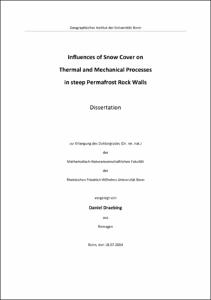Draebing, Daniel: Influences of Snow Cover on Thermal and Mechanical Processes in steep Permafrost Rock Walls. - Bonn, 2015. - Dissertation, Rheinische Friedrich-Wilhelms-Universität Bonn.
Online-Ausgabe in bonndoc: https://nbn-resolving.org/urn:nbn:de:hbz:5n-38536
Online-Ausgabe in bonndoc: https://nbn-resolving.org/urn:nbn:de:hbz:5n-38536
@phdthesis{handle:20.500.11811/6386,
urn: https://nbn-resolving.org/urn:nbn:de:hbz:5n-38536,
author = {{Daniel Draebing}},
title = {Influences of Snow Cover on Thermal and Mechanical Processes in steep Permafrost Rock Walls},
school = {Rheinische Friedrich-Wilhelms-Universität Bonn},
year = 2015,
month = feb,
note = {Degradation of rock permafrost can cause instability due to influences on rock- and ice-mechanical properties. Permafrost conditions can be altered by thermal processes and, thus, also mechanical properties of rocks. Snow cover controls the seasonal occurrence of thermal processes.
A conceptual approach is presented to explain snow cover influences on steep permafrost rock walls. This approach combines snow cover with thermal and mechanical processes. To support the conceptual approach, empirical data is presented to evaluate snow cover, the thermal and the mechanical regime. A combination of temperature data loggers, photos of automatic cameras and avalanche probe measurements allows the reconstruction of the temporal and spatial development of snow cover. Four snow stages can be distinguished and an overall cooling effect derived.
In laboratory measurements, p-wave velocities of 22 different alpine rocks are tested and the influence of ice pressure on seismic velocities is evaluated. P-wave velocity increases dependent on lithology due to freezing and increase is dominated by an increase of the velocity of the rock matrix due to ice pressure. These findings are incorporated into a novel time-average equation and provide the basis for the applicability of refraction seismics in permafrost rock walls.
The influence of snow cover on the thermal regime was investigated with the use of Seismic Refraction Tomography (SRT), Electrical Resistivity Tomography (ERT) and thermal modelling. Long lasting snow cover in 2013 delayed heat transport processes by insulating the underground and prevented active-layer thaw while snow cover absence resulted in deep thawing in 2012. Thus, snow cover plays a key role of permafrost evolution on slope facet scale.
Snow cover is the main controlling factor of discontinuity movement and rock decay. The snow cover controls the occurrence of thermal expansion/contraction and volumetric expansion as it prevents these processes, while favouring ice segregation due to isolation. Volumetric expansion increases short-term cryostatic pressure, whereas ice segregation leads to seasonal cryostatic pressure. Active-layer thaw decreases shear strengths during summer and increases instability seasonally.
The conceptual approach explains rock stability on seasonal and system scale. Therefore, this study delivers the basis in the understanding of stability of permafrost rock walls.},
url = {https://hdl.handle.net/20.500.11811/6386}
}
urn: https://nbn-resolving.org/urn:nbn:de:hbz:5n-38536,
author = {{Daniel Draebing}},
title = {Influences of Snow Cover on Thermal and Mechanical Processes in steep Permafrost Rock Walls},
school = {Rheinische Friedrich-Wilhelms-Universität Bonn},
year = 2015,
month = feb,
note = {Degradation of rock permafrost can cause instability due to influences on rock- and ice-mechanical properties. Permafrost conditions can be altered by thermal processes and, thus, also mechanical properties of rocks. Snow cover controls the seasonal occurrence of thermal processes.
A conceptual approach is presented to explain snow cover influences on steep permafrost rock walls. This approach combines snow cover with thermal and mechanical processes. To support the conceptual approach, empirical data is presented to evaluate snow cover, the thermal and the mechanical regime. A combination of temperature data loggers, photos of automatic cameras and avalanche probe measurements allows the reconstruction of the temporal and spatial development of snow cover. Four snow stages can be distinguished and an overall cooling effect derived.
In laboratory measurements, p-wave velocities of 22 different alpine rocks are tested and the influence of ice pressure on seismic velocities is evaluated. P-wave velocity increases dependent on lithology due to freezing and increase is dominated by an increase of the velocity of the rock matrix due to ice pressure. These findings are incorporated into a novel time-average equation and provide the basis for the applicability of refraction seismics in permafrost rock walls.
The influence of snow cover on the thermal regime was investigated with the use of Seismic Refraction Tomography (SRT), Electrical Resistivity Tomography (ERT) and thermal modelling. Long lasting snow cover in 2013 delayed heat transport processes by insulating the underground and prevented active-layer thaw while snow cover absence resulted in deep thawing in 2012. Thus, snow cover plays a key role of permafrost evolution on slope facet scale.
Snow cover is the main controlling factor of discontinuity movement and rock decay. The snow cover controls the occurrence of thermal expansion/contraction and volumetric expansion as it prevents these processes, while favouring ice segregation due to isolation. Volumetric expansion increases short-term cryostatic pressure, whereas ice segregation leads to seasonal cryostatic pressure. Active-layer thaw decreases shear strengths during summer and increases instability seasonally.
The conceptual approach explains rock stability on seasonal and system scale. Therefore, this study delivers the basis in the understanding of stability of permafrost rock walls.},
url = {https://hdl.handle.net/20.500.11811/6386}
}






